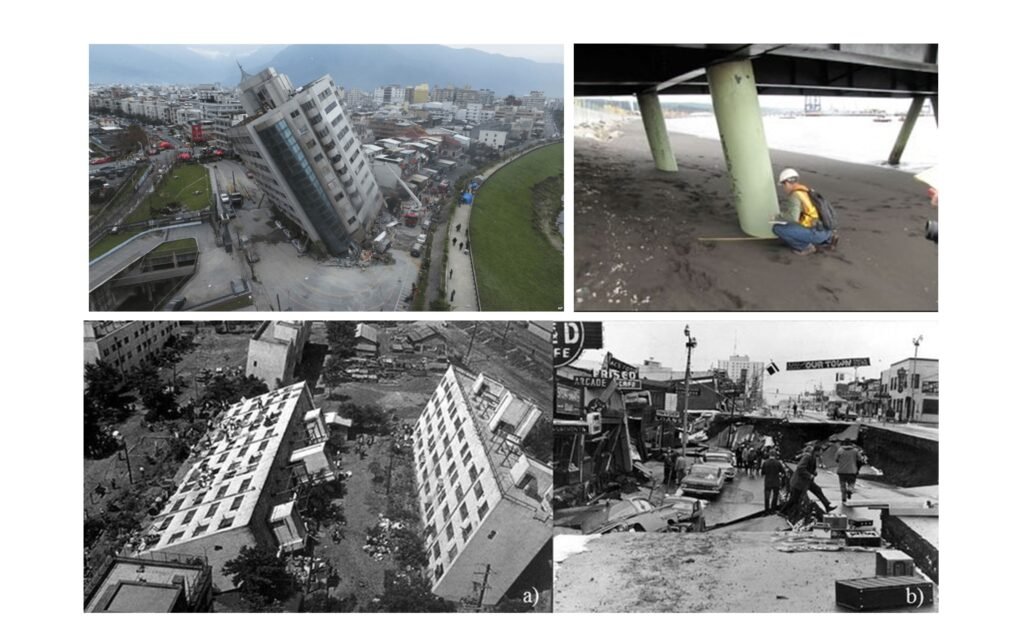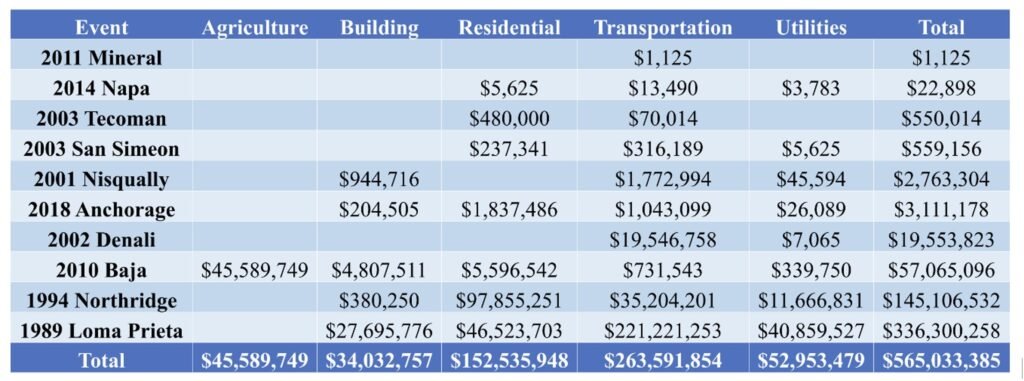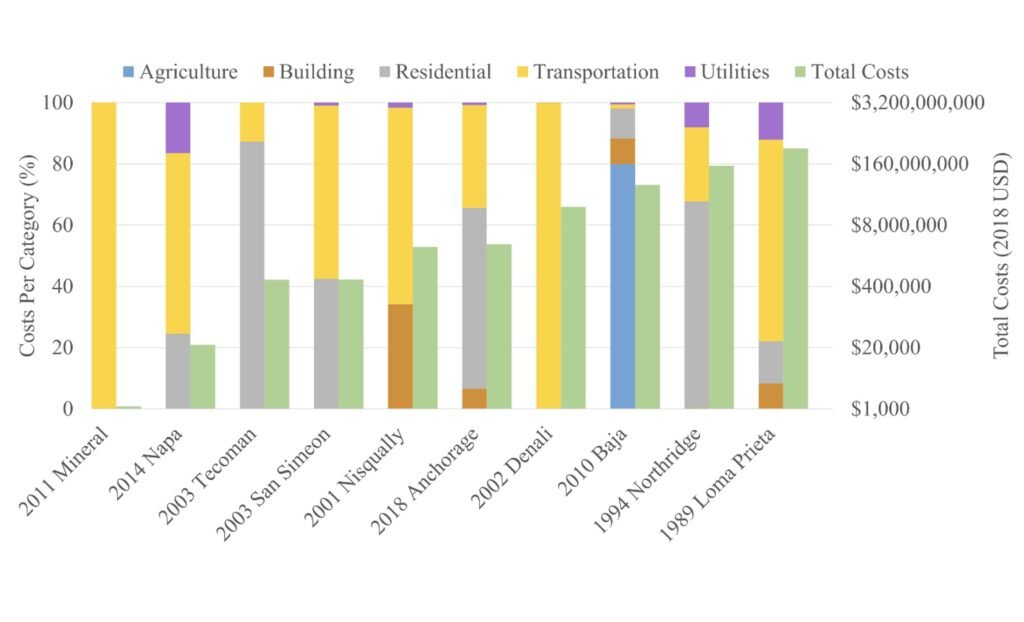

Soil liquefaction and its economic consequences
Soil liquefaction is a phenomenon typically associated with the occurrence of earthquakes, which generates the loss of shear strength of the soil and the consequent occurrence of significant deformations in it, with often devastating effects for structures and service infrastructure that turn into millions of dollars in losses Do you want to know more about this topic? Continue reading this post...
Content
What soil liquefaction is
Basically, we can say that liquefaction is the process by which a sediment that is submerged (i.e., below the water table) experiences a loss of strength and ceases to behave as a solid and becomes a viscous liquid. Any soil can liquefy, although the types of sediments most susceptible to liquefaction are clean sands and silts, with a low percentage of clay colloids.
Typically, liquefaction is produced by the action of seismic waves (primarily shear waves), which pass through saturated granular soil strata, distorting the soil structure and causing the collapse of groups of particles that are under a loose arrangement. These collapses increase the pore pressure between soil grains when drainage cannot occur and, recalling the Principle of Effective Stresses proposed by Terzaghi, what physically happens is that, if the pore pressure reaches values close to the weight of the overlying soil, the granular soil layer temporarily behaves as a viscous liquid, losing its shear strength. At this point liquefaction occurred.
What does liquefaction depend on? There are three factors that significantly influence the susceptibility to liquefaction, which should be analyzed as completely as possible in geotechnical studies developed in soils where this type of phenomenon is suspected to occur, and they are the following:
- Soil density
- Clay and/or cementitious agents content in the soil structure
- Drainage restrictions
Figure 1 schematically illustrates the liquefaction process, highlighting the effects of the occurrence of the phenomenon on the soil structure.

Figure 1 Soil liquefaction phenomenon: a) submerged granular soils of low compactness; b) increase in pore pressure and loss of shear strength due to the effect of seismic waves; c) densification of the soil after the earthquake. (Source: available at https://www.geotech.hr/en/soil-liquefaction/).
From the figure above, it is important to highlight that, once liquefaction has occurred, soil particles are rearranged in a denser state, which results in significant deformations of the soil and, therefore, of the structures supported on it.
As an additional comment to take into account when developing a geotechnical study, it is important to note that liquefaction is restricted to geological environments of recent deposits of sands and silts in which the groundwater level is close to the surface. Thus, the sediments most susceptible to liquefaction are typical of deltaic formations, river margins, flood areas, aeolian deposits, and poorly compacted hydraulic fills. The SCEC/USC (1999) defines liquefaction hazard zones, and the EERI (1994) states that the liquefaction phenomenon can generate various types of failures, namely: a) flow failure; b) lateral displacement; c) ground oscillations; d) loss of soil bearing capacity; e) settlement; f) increase of lateral pressure in retaining walls.
Affectation on civil facilities
As can be seen from previous section, it is clear that soil liquefaction can have disastrous effects on buildings and service facilities, especially associated with post-liquefaction settlements. Some effects of the occurrence of the phenomenon are shown in Figure 2.

Figure 2 Soil liquefaction effects (Source: compiled from https://www.google.com/).
In general, the possible effects on civil facilities can be summarized as follows:
- Building failures. The foundations of a building are designed according to the bearing capacity of the soil. In case of liquefaction, as mentioned above, the bearing capacity of the soil practically desapears, resulting in the building sinking into the ground, tilting, or even overturning. In addition, in less severe cases, post-liquefaction differential settlements can generate the appearance of cracks in the structure.
- Foundation cracking. The irregular settlement of the foundations can cause the appearance of cracks of certain importance in the foundations, which translates into a dangerous situation for the safety of the structure, since cracked foundations do not distribute the load evenly over the ground.
- Slope slides. Liquefaction can practically destroy some slopes. During the occurrence of the phenomenon, large fissures and cracks may be generated in the body of the slopes, from which the material flows down and settles at the base, representing a potential threat to nearby structures and public services.
- Retaining wall failures. A retaining wall fails by sliding, tilting or overturning. The liquefied soil exerts an additional load on the retaining wall and can cause the wall to fail, particularly when the drainage system is plugged
- Pile damage. The pile foundation acts as a column that transfers the structural load to the deeper strata. The liquefied soil exerts a lateral pressure on the pile that causes it to buckle, causing the pile to deform and significantly decrease its bearing capacity or even split (as has been documented in numerous seismic events over the years).
- Effects on public utilities. Liquefaction especially affects public utilities, such as water, sewer and gas pipes, sidewalks and streets in general, since these structures are characterized by their low stiffness.
According to this brief account, it is evident that the liquefaction phenomenon can cause significant damage to all types of structures and services.
Soil liquefaction and its economic consequences
In general, we can say that ground liquefaction constitutes a potential secondary hazard associated with earthquakes, but that it can nevertheless cause serious damage to infrastructure, contributing significantly to the economic losses associated with the occurrence of seismic events.
To provide insight into the economic consequences of liquefaction phenomena, Table 1 presents information compiled by Chansky et al (2019) on American earthquakes, in a work developed at Tufs University under the auspices of the USGS.
Table 1 Breakdown of costs due to liquefaction associated with different earthquakes in USA (Source: Chansky et al, 2019).

Figure 3 illustrates the costs associated with the above events as a percentage of the total estimated cost for each event.

Figure 3 Percentage costs associated with the total estimated costs for each individual seismic event. (Source: Chansky et al, 2019).
However, it is important to note that, as Chansky et al point out, compiling information on damage likely associated with soil liquefaction is a very complicated task, involving the review of government sources, reports, scientific papers and press articles, and then assigning a value to the replacement cost of that damage from various other sources (such as civil engineering consultants, insurance companies, and banks, among others).
A manera de comentario final, vale destacar que el calcular de manera precisa las pérdidas asociadas a la ocurrencia de licuación durante un evento sísmico, permitiría estimar de manera mucho más precisa el impacto económico global de un terremoto, lo que, a su vez, serviría de base para que los entes gubernamentales, empresas aseguradoras, y el gremio ingenieril, tomen las previsiones económicas necesarias.
References
- Amundaray, J. I. (2006) “Suelos potencialmente licuables y medidas de remediación”. Ingeniería Forense y Estudios de Sitio / Guía para la Prevención de Gestión de Riesgos. Prensas Venezolanas. Caracas, Venezuela.
- Boiero, A., Amundaray, J., Grases, J. y Tamargo, L. (2008) “Evaluación del potencial de licuación, técnicas de mejoramiento del subsuelo y obtención del espectro de respuesta sísmico”. Conferencia 50th Aniversario de la Sociedad Venezolana de Geotecnia. Caracas, Venezuela.
- Chansky, A.; Baise, L; & Meyer, M. (2019) “Liquefaction loss estimation in US”. American Geophysical Union, Fall Meeting. Moscone Center, San Francisco, USA.